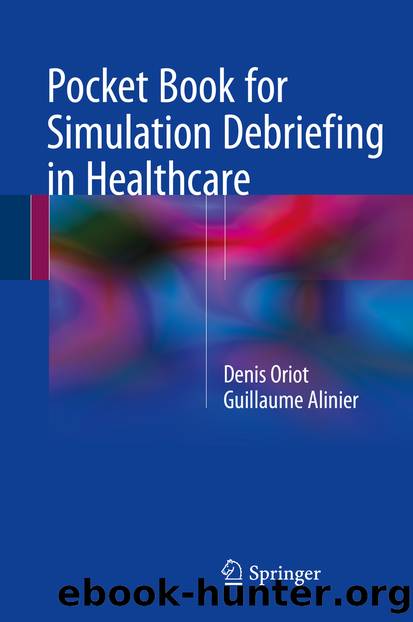Pocket Book for Simulation Debriefing in Healthcare by Denis Oriot & Guillaume Alinier

Author:Denis Oriot & Guillaume Alinier
Language: eng
Format: epub
Publisher: Springer International Publishing, Cham
2.6.4 How to Modulate the Use of Advocacy-Inquiry During Debriefing?
Advocacy-inquiry is not a debriefing strategy generally used on its own but rather needs to be utilised in conjunction with other techniques that also promote reflection and understanding of scenario participantsâ actions. âPromoting Excellence and Reflective Learning in Simulationâ (PEARLS) has recently been presented as an integrative approach of debriefing (Cheng et al. 2016a; Eppich and Cheng 2015). In this PEARLS approach , the authors differentiate three strategies of providing a feedback during debriefing according to the nature of the performance gaps: directive feedback, facilitator-driven plus/delta debriefing, and advocacy-inquiry (Eppich and Cheng 2015). Their differential use depends on various parameters such as time allocated for the debriefing, evidence of rationale to close the performance gap, and type of performance gap, i.e. knowledge (cognitive), skills (technical), or attitudes (communication, CRM). In their view, directive feedback is useful when time is short, the rationale is evident, and it is a gap related to technical or cognitive issues. On the other hand, the advocacy-inquiry technique is preferable when there is more time, the rational is not evident, and it is about addressing a gap dealing with cognitive or behavioural issues. The plus/delta strategy can be considered as a mixture of both (Eppich and Cheng 2015). Despite the fact that time could be limited and may modify the strategy that can be used effectively, we think that even facing technical gaps with rational-based evidence, using a structured debriefing approach with the advocacy-inquiry investigation technique is worthwhile as demonstrated through our previous example regarding CPR and IO access. Advocacy-inquiry may be used with a scenario participant to genuinely uncover what really happened and why so everyone, including the debriefer(s), can understand their mental frame. It may also be used for teaching purposes, whereby the debriefer had a clear idea of the scenario participantâs mental frame but wants all learners to clearly understand their peerâs thinking process and/or actions. Several of the points to reconsider are presented in the last column of Table 1.â5.
An educational strategy and conversational technique used since the late 1980s in family therapy, potentially complementing the advocacy-inquiry approach, is called âcircular questioningâ. It can be used in simulation debriefing as a form of focused facilitation to explore teamwork patterns (Kolbe et al. 2016). The major guiding principle of circular questioning is a communication process of creating distinctions and connections (Brown 1997). Creating differences while questioning is the fundamental principle underlying all question types. These differences include distinctions over time (âWhen did this problem begin?â, âWhen was it the most difficult?â), between people (âWho among you all think that this was the most appropriate therapy?â), between parts of a person (âDo you think that at that time you were ruled more by your feelings or by your thoughts?â), and between situations (âIn what situation is the problem most noticeable?â) (Brown 1997). Then drawing connections include questioning about behaviours (âWhat happened after you asked him/her to do thisâ¦? What happened then? How did it all
Download
This site does not store any files on its server. We only index and link to content provided by other sites. Please contact the content providers to delete copyright contents if any and email us, we'll remove relevant links or contents immediately.
Periodization Training for Sports by Tudor Bompa(8170)
Why We Sleep: Unlocking the Power of Sleep and Dreams by Matthew Walker(6618)
Paper Towns by Green John(5089)
The Immortal Life of Henrietta Lacks by Rebecca Skloot(4525)
The Sports Rules Book by Human Kinetics(4294)
Dynamic Alignment Through Imagery by Eric Franklin(4118)
ACSM's Complete Guide to Fitness & Health by ACSM(3989)
Kaplan MCAT Organic Chemistry Review: Created for MCAT 2015 (Kaplan Test Prep) by Kaplan(3940)
Introduction to Kinesiology by Shirl J. Hoffman(3726)
Livewired by David Eagleman(3684)
The Death of the Heart by Elizabeth Bowen(3552)
The River of Consciousness by Oliver Sacks(3541)
Alchemy and Alchemists by C. J. S. Thompson(3451)
Bad Pharma by Ben Goldacre(3356)
Descartes' Error by Antonio Damasio(3230)
The Emperor of All Maladies: A Biography of Cancer by Siddhartha Mukherjee(3066)
The Gene: An Intimate History by Siddhartha Mukherjee(3047)
The Fate of Rome: Climate, Disease, and the End of an Empire (The Princeton History of the Ancient World) by Kyle Harper(3003)
Kaplan MCAT Behavioral Sciences Review: Created for MCAT 2015 (Kaplan Test Prep) by Kaplan(2940)
